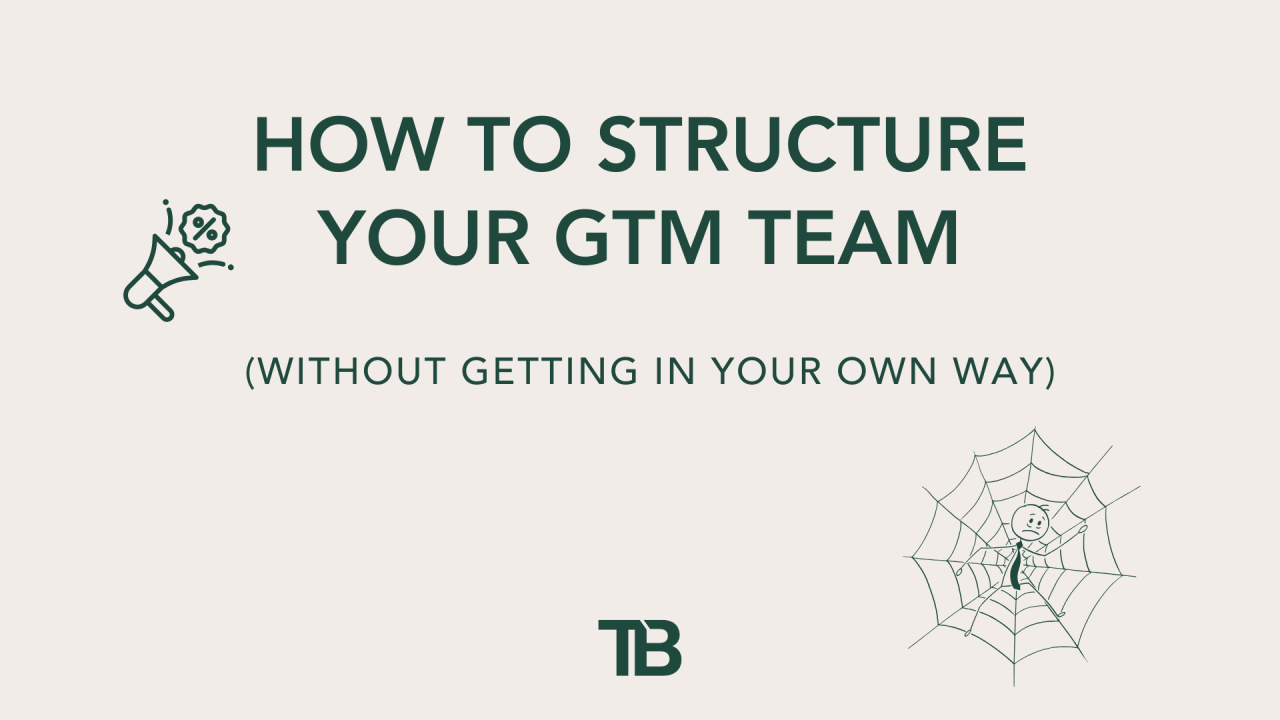In this newsletter, I break down why most GTM teams are misaligned and how to restructure yours around your customer’s actual journey, not your internal process.
This might be the single most important thing most tech companies get wrong: how they structure their go-to-market (GTM) team.
Not because they’re not trying hard enough, but because they often end up getting in their own way.
Let’s get one thing straight: The goal of your GTM team should be simple: to drive revenue and customer satisfaction.
Specifically:
- Close more deals = grow ARR
- Launch faster = speed up revenue recognition
- Deliver better experiences = boost NPS
- Create long-term value = increase expansion ARR
So why do so many teams end up over-engineering their internal sales methodology, onboarding process, and handoffs, forcing customers into a rigid journey that creates friction at every step?
It makes no sense.
The Answer?
Let your ideal customer define the journey, and structure your GTM team around that. Not the other way around.
I’ve been on both sides of the table.
As a tech executive, I’ve bought and implemented solutions for global brands. As a SaaS executive, I’ve sold into those same brands.
Here’s what I see over and over again: Companies build internal processes and stick to a rigid methodology even when the customer is clearly signaling, “This won’t work.”
Why?
- They believe their flow is the most efficient way to showcase the product
- They prioritize internal efficiency over actually closing deals or supporting customers
- They assume they’ll drive more revenue by designing the journey their way
- Or a sales leader insists on using a methodology that worked in a previous company, without adapting it to the current customer or context
You don’t need a perfect playbook. You need a flexible framework built around your customer’s reality.
When teams ignore this, they make short-term decisions just to close a deal, only to have the whole thing fall apart at go-live.
Ever seen a C-suite buyer re-explain everything to a new onboarding rep who was left out of the loop? That’s not just a bad experience, it’s bad business.
If you want to build a sustainable, customer-led business, here are the non-negotiables when it comes to GTM structure.
Step-by-Step: How to Structure Your GTM Team Around Your Customer
1. Reverse Engineer Your Ideal Customer Journey
Forget your internal stages and processes for a moment. Start by spending time with your ideal customers, both current and prospective. Listen. Observe.
Find out:
- Why do they switch? What pain are they solving?
- Who makes decisions? Is it IT, the business, or procurement?
- Do they expect FaceTime with execs before buying?
- How do they typically onboard a new vendor?
- Do they expect white-glove service, or are they self-serve?
- What are their timelines, payment terms, and risk profiles?
Now zoom out. How does their industry work? Are there old-school RFP processes? Do they have the internal capabilities to implement your product?
This step alone will give you critical insights to reshape your entire GTM approach.
2. Re-evaluate Your Product and Offering
- How does your product actually help this customer?
- What’s the best way to showcase that, a lab, a demo, a pilot? And who will you need across your teams to help with this?
- Who are you replacing? Legacy tech? Manual processes?
- Will implementation be high-friction? What integrations might you need to unwind?
- Who do you need on your side to make this easy, pro services, custom dev builders, or external help?
This will tell you what kind of support, staffing, and timeline your team needs to win and keep the customer.
3. Audit Your Internal Teams
Now it’s time to look inward.
- Do your teams mirror the journey your customer is on?
- Are roles clearly defined across sales, onboarding, and customer success?
- Where are the handoffs, and are they frictionless?
- Can you reduce silos (ex: combine solutions and pro-serv) to make go-live smoother?
- Do you have the right PM tools and resourcing?
- Do your teams get ongoing product feedback directly from the customer?
- Are incentives aligned across pre-sales and post-sales? How can both work together regardless of the stage?
Often, you’ll realize that small adjustments, like better collaboration between sales and post-live technical teams before the deal is signed, go a long way in improving outcomes.
4. Think About It From a Financial Lens
Yes, a customer-led approach might seem high-touch at first. But the irony? It’s usually more efficient in the long run.
Instead of building a bloated, siloed org, you combine roles, streamline processes, and focus on what really matters: outcomes for the customer. That’s how you scale without wasting headcount.
5. Redesign the Journey, Then Evolve It
Now that you understand your customer’s world and your team’s capabilities, you can:
- Redesign your customer journey with clear, relevant touchpoints
- Think AI first:
Side note: I truly believe that with the rise of AI, the tech companies that reverse-engineer their customer journeys with an AI-first mindset, one that’s fully aligned to how customers buy, implement, and grow, will begin to separate themselves from those who simply bolt AI onto existing processes. The winners will be the ones who think holistically across every team, aren’t afraid to reinvent roles and workflows, and design their GTM structure around how they can best serve the customer, powered by AI, not constrained by legacy thinking.
- Assign the right teams with the right capabilities to each step
- Align incentives and responsibilities across departments
- Treat this as a living playbook, and keep evolving it
Final Thought:
Your GTM team should feel like a natural extension of how your customer wants to buy, implement, and succeed.
Don’t let internal processes, org charts, or legacy thinking get in the way.
The companies that win over time aren’t the ones with the most polished sales decks, they’re the ones who align their team to deliver value, end-to-end.
Let your customer build the map.
You build the vehicle.

 How to Structure Your GTM Team (Without Getting in Your Own Way)
How to Structure Your GTM Team (Without Getting in Your Own Way)